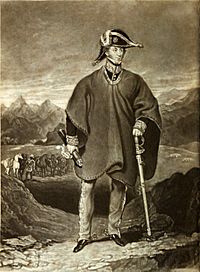Guillermo Miller facts for kids
Quick facts for kids
Guillermo Miller
|
|
|---|---|

Miller, in the uniform of the general of the army of Peru, during the Ayacucho campaign
|
|
| Native name |
William Miller
|
| Born | 2 December 1795 Wingham, England |
| Died | 31 October 1861 Lima, Peru |
| Allegiance | |
| Rank | Grand Marshal of Peru |
| Battles/wars | Peninsular War |
William Miller (born December 2, 1795, died October 31, 1861) was an English soldier. He is known in South America as Guillermo Miller. He fought in many wars for independence in South America. Later, he became a diplomat, representing Britain in other countries.
Contents
William Miller's Life Story
William Miller was born on December 2, 1795, in Wingham, Kent, England. By the time he was seventeen, he could speak several languages. He joined the British army to fight in the Napoleonic Wars. He took part in important battles like the Siege of Badajoz and the Battle of Vitoria. He served under the famous Duke of Wellington.
In September 1817, Miller heard about the wars for independence happening in Latin America. He decided to sail to Buenos Aires to join San Martín's Army of the Andes.
Fighting for Chile's Freedom
Miller played a part in San Martín's efforts to free Chile. He fought in the very important Battle of Maipú. After this, he joined Lord Cochrane as a commander of marines in the Chilean Navy.
He helped Lord Cochrane capture Valdivia, leading a group of 60 soldiers. He also took part in an expedition to Chiloé, though it was not successful. He also fought in the smaller but important Battle of Agüi.
Helping Peru Gain Independence
After the city of Lima, Peru was freed, Miller was put in charge of the Peruvian Legion. Even when he was sick with malaria, General Miller was very important in the Battle of Torata. He bravely led his troops to take over hills when it seemed like all hope was lost.
Peru's President José de la Riva Agüero promoted Miller to General of Brigade. When Simón Bolívar arrived, Miller was promoted again. He became the chief of a cavalry unit. This unit included soldiers from Argentina and Chile who had come with San Martín, along with many Peruvians and Colombians.
Key Battles in Peru
At the Battle of Junín, Miller's cavalry unit was a big reason why the Spanish forces were defeated. Later, at the Battle of Ayacucho, he made a bold decision. He launched an attack at a crucial moment without waiting for orders from Sucre. This quick action was key to winning the battle.
During these wars, Miller was wounded 22 times. After he died, doctors found two bullets in his liver that he had carried for 40 years!
The Hussars of Junín
Miller created a special cavalry unit called the Hussars of the Peruvian Legion. They were so brave at the Battle of Junín that they changed the course of the fight. Because of their heroism, they were renamed the "Hussars of Junín." Today, these same Hussars still guard the Peruvian Palace of Government in Lima.
After the war ended, Miller settled down in Lima. On June 11, 1834, he was promoted to Grand Marshal. This was the highest military rank in Peru. He held several public jobs. However, he disagreed with the governments after 1836, especially about how they treated the native people. Because of this, he lost his rank as Grand Marshal on March 25, 1839. He later got all his ranks and privileges back, but he never again held a political or military command in Peru. His brother, John, wrote a two-volume book about his life in 1828.
Diplomatic Work in Hawaii
In 1843, Miller became the British diplomat, or Consul, for Pacific islands like the Kingdom of Hawaii. He arrived in Honolulu in January 1844 with his friend, Robert Crichton Wyllie. Wyllie helped him in Hawaii while Miller traveled to other Pacific islands. Wyllie later became the Minister of Foreign Affairs for the Kingdom of Hawaii.
For a short time in 1859, Busvargus Toup Nicolas took Miller's place as consul.
Later Years and Legacy
When Nicolas returned home due to illness, an English merchant named William Lowthian Green acted as consul. Eventually, William W. F. Synge was sent as a permanent replacement.
Miller passed away in Callao, Peru, on October 31, 1861, at the age of 65. He was first buried in the Old British Cemetery in Bellavista. In the 1920s, his body was moved to the Panteon de los Proceres. This is a special place where heroes of the War of Independence are laid to rest.
Today, there is a house named after him at Markham College in Peru. There is also a street in his hometown of Wingham, England, named in his honor. A plaque, given by the Peruvian government in 2006, can be found inside St. Mary's Church there.
See also
 In Spanish: Guillermo Miller para niños
In Spanish: Guillermo Miller para niños


